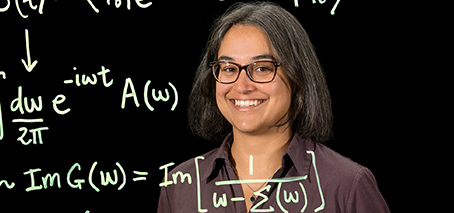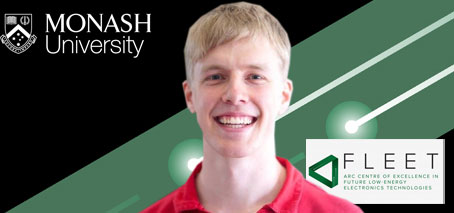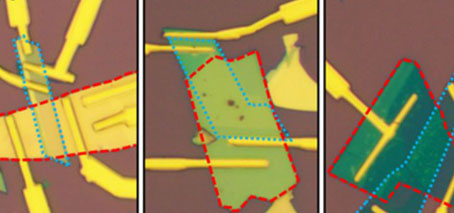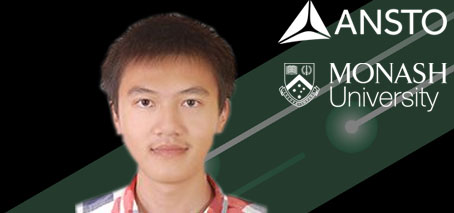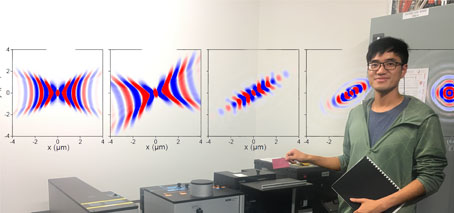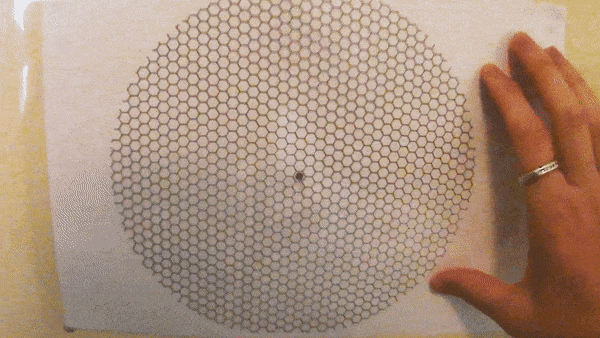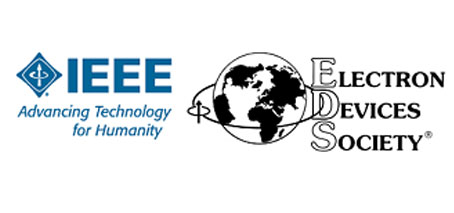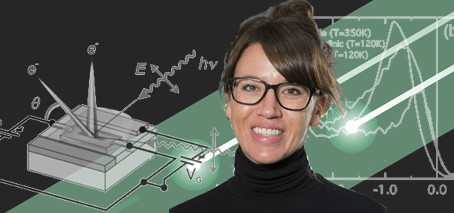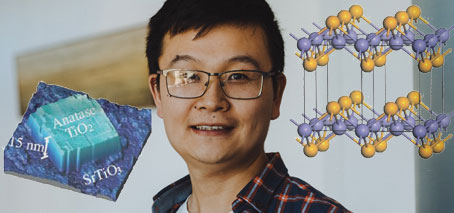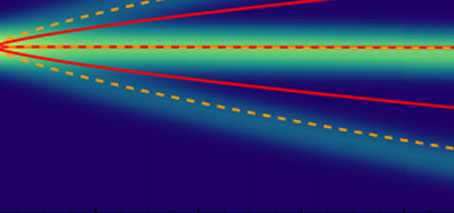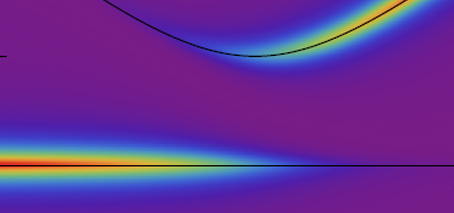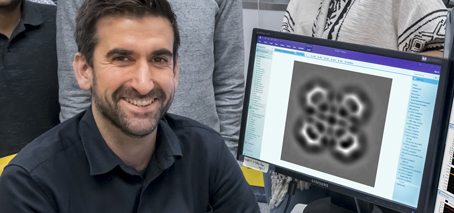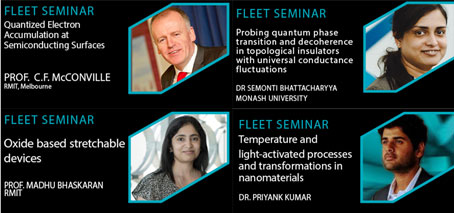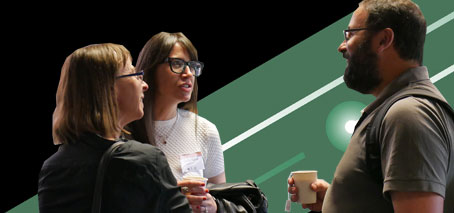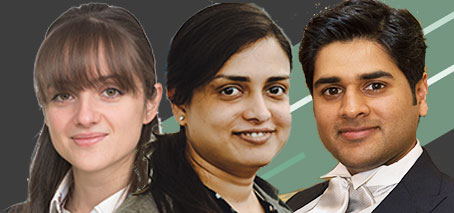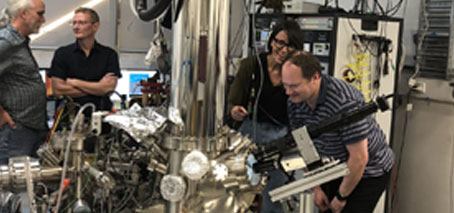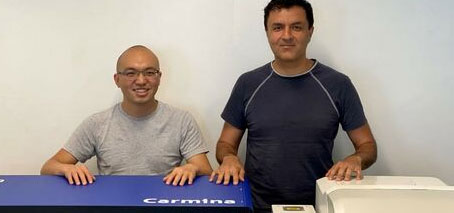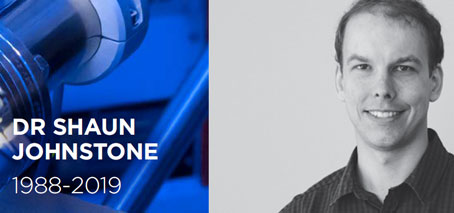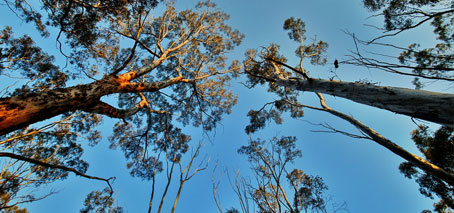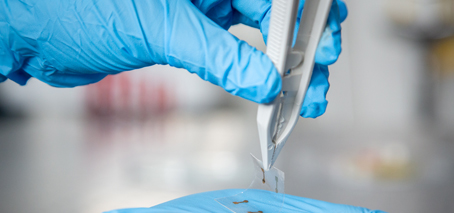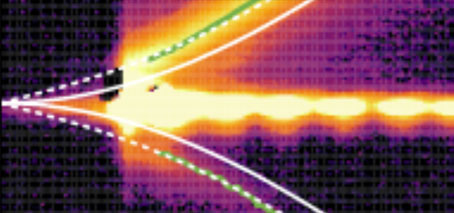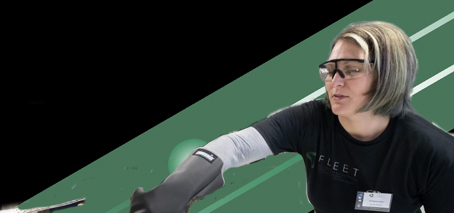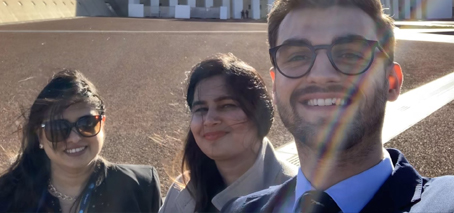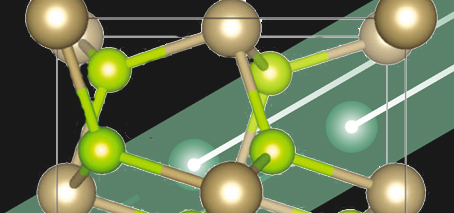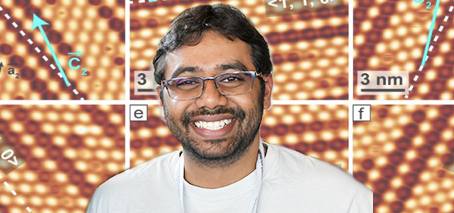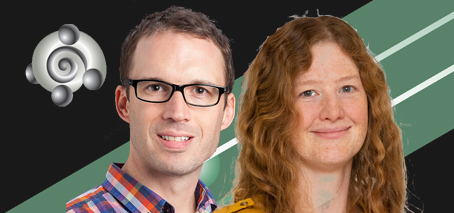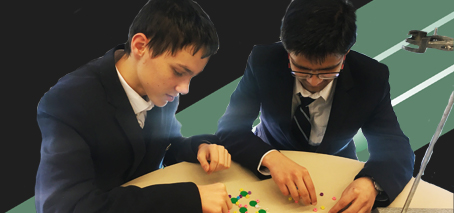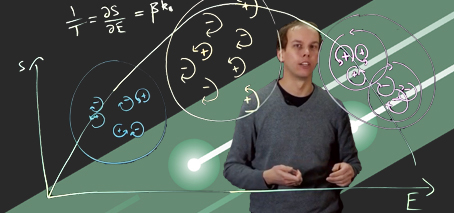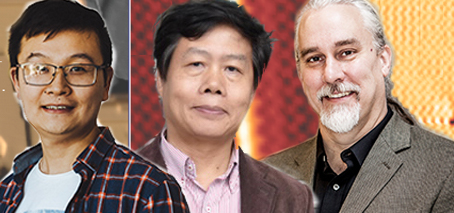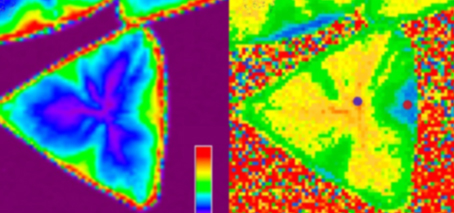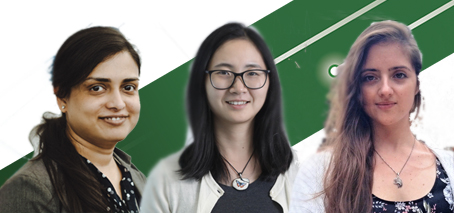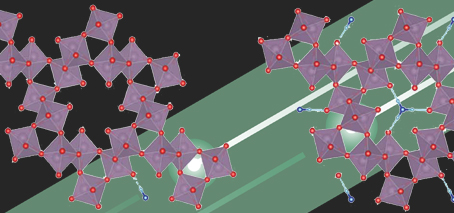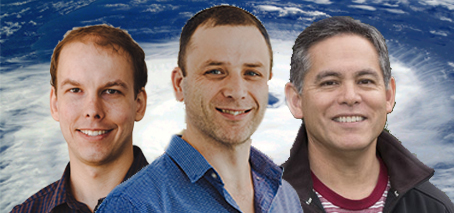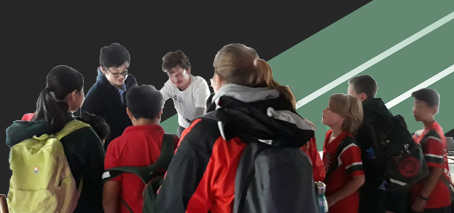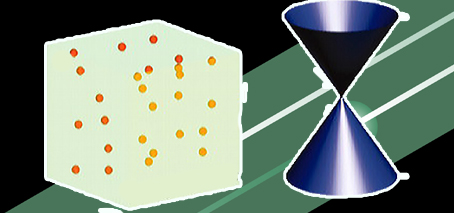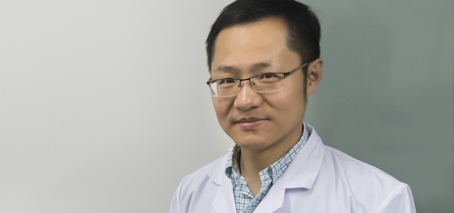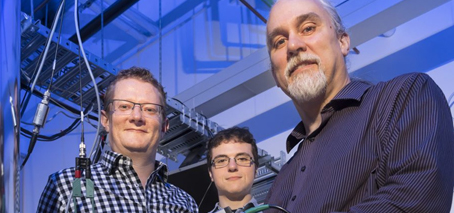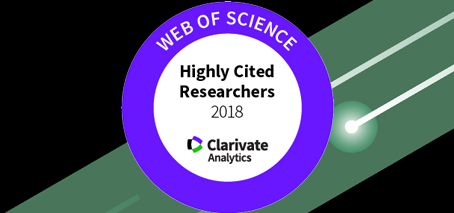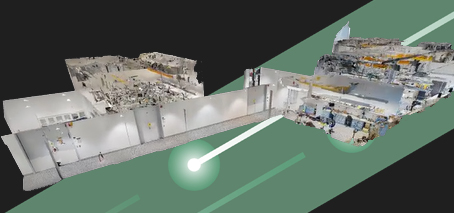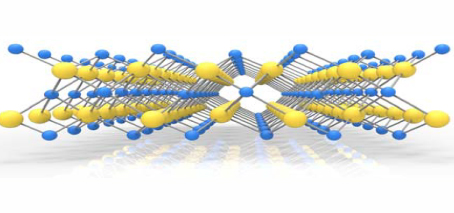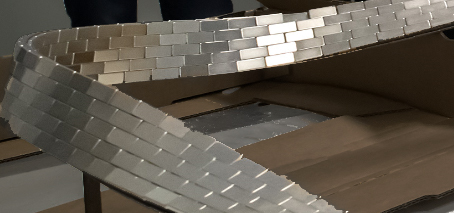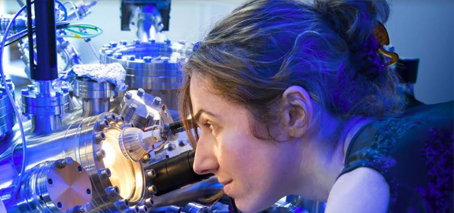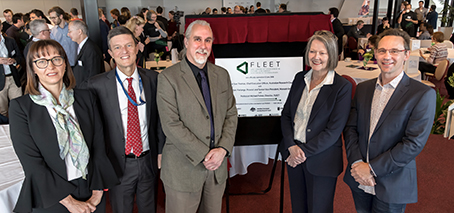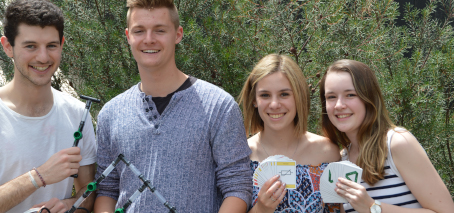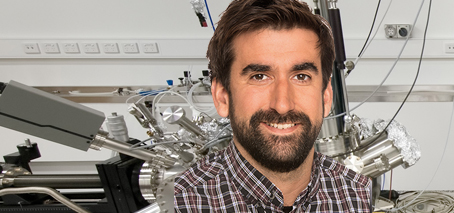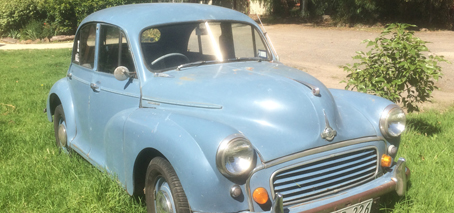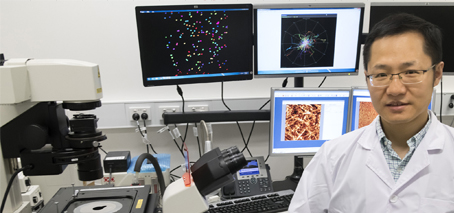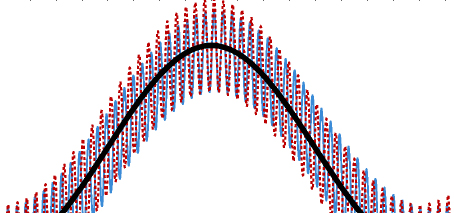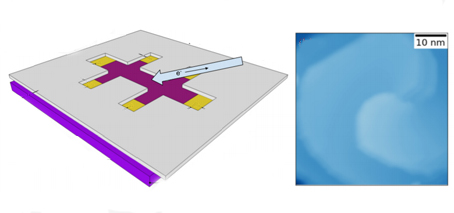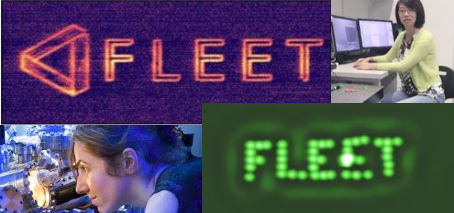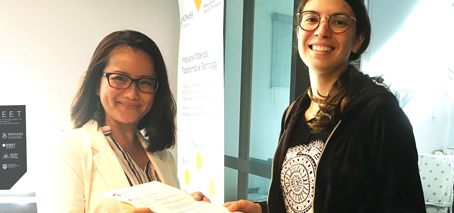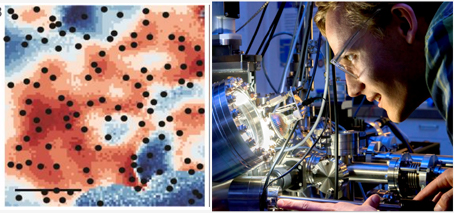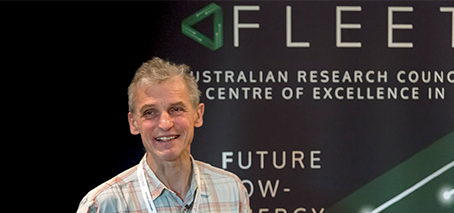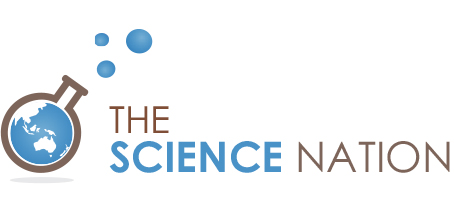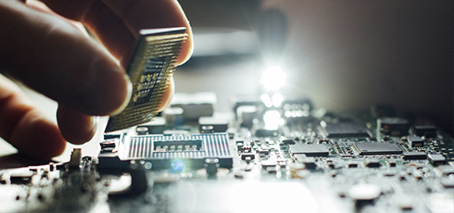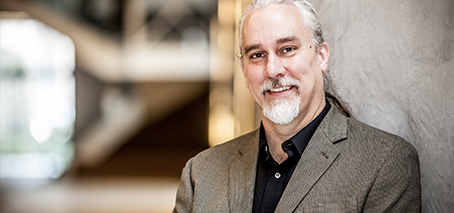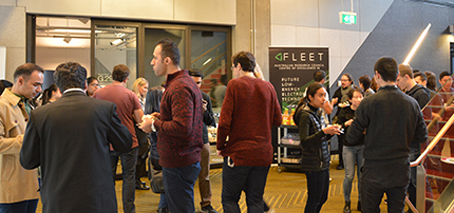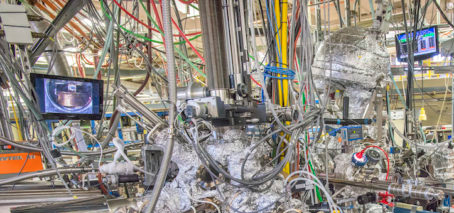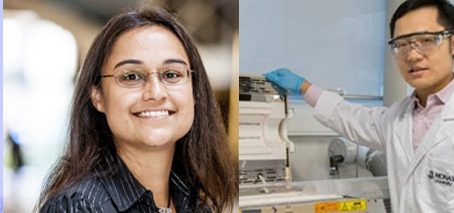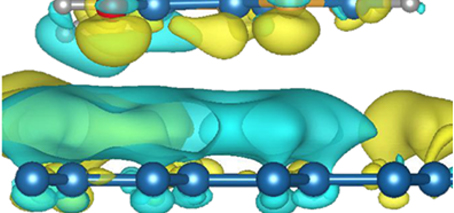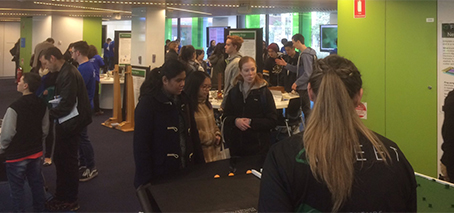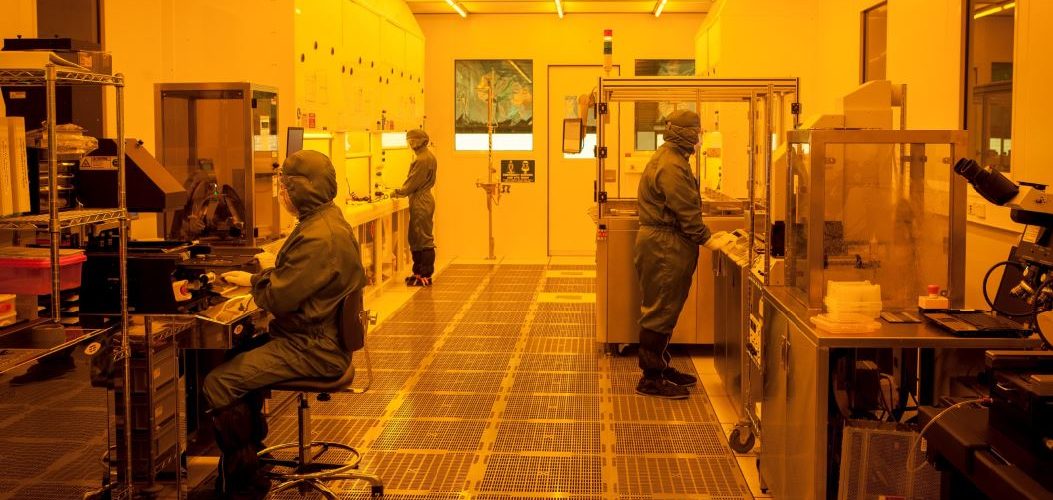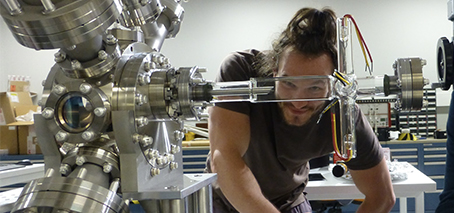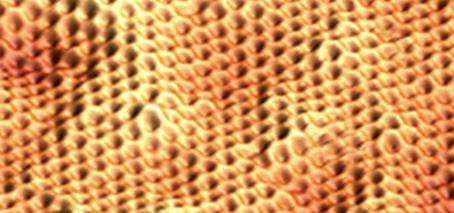Congratulations to FLEET CI A/Prof Meera Parish who received an ARC Future Fellowship in this week’s announcement. “The revolution in electronics and the Information Age were enabled by powerful theories based on the concept of the quasiparticle, an object composed of many particles such as electrons,” writes A/Prof Parish. The new ARC Fellowship will support Meera’s work to unravel the …
Matt Gebert: outreach champion
Congratulations to FLEET PhD student Matt Gebert, recognised for his dedication to science-outreach by the Monash Faculty of Science. Matt’s contributions to science outreach include running lab tours with Monash Tech School, demonstrating levitating superconductors and speaking at Monash University open day, teaching regional students via the Emerging Science Victoria program, coordinating PhD day, and in-class demos and talks, including …
Behind the scenes at Monash
Shooting for an all-online open day featuring FLEET’s material labs at Monash University’s New Horizons building, FLEET Research Fellow Dr Semonti Bhattacharyya with School of Physics and Astronomy Steve Morton. See the resulting video on Monash Physics youtube.
International collaboration unlocks vdW heterostructure
2D vdW TMD heterostructures studied Study correlates interface physics to device performance An India-Australian theoretical and experimental study for high-performance optoelectronics has been published in Nano Letters. The Monash University collaboration with the Indian Institute of Technology Bombay (IITB) designed and fabricated a heterostructure comprising two layered transition metal dichalcogenides (WSe2 and ReS2). Integrating new physics in vdW heterostructures Van-der-Waals …
ANSTO Scholarship for FLEET PhD Qile Li
Congratulations to FLEET PhD student Qile Li, whose excellent work in probing electronic structures of novel materials has been recognised by an award and scholarship from the Australian Institute of Nuclear Science and Engineering (AINSE). At ANSTO’s Australian Synchrotron, Qile Li uses Angle-Resolved Photo-Electron Spectroscopy (ARPES) to measure electronic properties of intrinsic magnetic topological insulators. Intrinsic magnetic topological insulators are …
Applying ‘magic angle’ twistronics to manipulate the flow of light
‘Twisted’ layers of 2D materials produce photonic topological transition at ‘magic’ rotation angles Principles of Moire-pattern bilayer graphene applied to 2D material photonics for first time Monash researchers are part of an international collaboration applying ‘twistronics’ concepts (the science of layering and twisting 2D materials to control their electrical properties) to manipulate the flow of light in extreme ways. The …
Explainer: Moire patterns in graphene and plastic
A recent FLEET homescience exercise explained how simple geometric patterns printed on transparency (‘overhead projector sheets’, to those of us old enough to remember such technology), and overlaid at varying angles, produced a combined ‘Moire’ pattern of varying dimensions. Two sheets of repeating squares produces a Moire pattern of larger squares. Two sheets of repeating triangles produces a Moire pattern …
What comes after CMOS? An expert discussion
A panel of experts featuring Dr Paolo Gargini (formerly Intel, head of several international semiconductor roadmaps), Prof Michelle Simmons (UNSW, Director. ARC Centre for Quantum Computation and Communication Technology) and Prof Michael Fuhrer (Monash Uni., Director of ARC Centre of Excellence in Future Low Energy Electronics Technologies.) and a guided discussion about the future of electronics beyond CMOS and the role semiconductors and other materials …
New CI Julie Karel
It is a great pleasure to announce that Dr Julie Karel (Monash) is now a FLEET Chief Investigator. Dr Karel conducts research at the intersection of materials science and condensed-matter physics, to develop new materials for emerging low-energy nanoelectronic and magnetoelectronic devices. Within FLEET Dr Karel will pursue two research streams: Modification of materials through ionic liquid gating, towards FLEET’s goal …
Interfaces the key in atomically-thin, ‘high temperature’ superconductors
An international FLEET collaboration publishing a review of atomically-thin ‘high temperature’ superconductors finds that each has a common driving mechanism: interfaces. The team, including researchers from the University of Wollongong, Monash University and Tsinghua University (Beijing), found that interfaces between materials were the key to superconductivity in all systems examined. The enhancement of superconductivity at interfaces (interface superconductivity enhancement effect) …
Splitting quasiparticles with temperature: the fate of an impurity in a BEC
A new theoretical study at Monash University has improved our understanding of the interplay between quantum and thermal fluctuations (or excitations) in quantum matter. The study found that an impurity within a Bose-Einstein condensate (BEC) exhibits an intriguing energy spectrum as its temperature is raised above zero kelvin, with the ground-state quasiparticle splitting into a number of branches that depends …
Applying quantum-impurity theory to quantum fluids of light
A Monash-led study develops a new approach to directly observe correlated, many-body states in an exciton-polariton system that go beyond classical theories. The study expands the use of quantum impurity theory, currently of significant interest to the cold-atom physics community, and will trigger future experiments demonstrating many-body quantum correlations of microcavity polaritons. Exploring quantum fluids “Exciton-polaritons provide a playground in …
Putting artificial intelligence to work in the lab
Automated Scanning Probe Microscopy (SPM) controlled by artificial intelligence First demonstration of fully autonomous, long-term SPM operation An Australian-German collaboration has demonstrated fully-autonomous SPM operation, applying artificial intelligence and deep learning to remove the need for constant human supervision. The new system, dubbed DeepSPM, bridges the gap between nanoscience, automation and artificial intelligence (AI), and firmly establishes the use of …
Hosting research seminars in 2019
FLEET’s live-streamed seminars help share research results across the Centre, keeping members informed on latest FLEET research, and enhancing inter-node collaboration. Early-career researchers presenting the seminars gain valuable presentation experience, and benefit from immediate feedback on their research from diverse Centre members. In 2019, FLEET-wide live-streamed seminars were presented by: Dr Dan Sando (UNSW) Dr Jackson Smith (RMIT) Dr Maciej …
Hosting scientific meetings in 2019
FLEET supported significant international and Australian conferences in 2019, which was bookended by major, FLEET-hosted conferences at the end of 2018 (ICON2D-Mat) and beginning of 2020 (ICSCE). With new partner organisation the MacDiarmid Institute (NZ), FLEET co-organised the Conference on Signature of Topology in Condensed Matter in Italy, working closely with the International Centre for Theoretical Physics. Almost 120 researchers …
Three FLEET ECR Grant recipients
First recipients of FLEET ECR Grants Grants funding research trips to Italy, Singapore, US FLEET’s ECR Grants fund travel for ECRs and PhDs, developing networks and professional and scientific skills, including supporting travel to research facilities to learn new techniques, form new collaborations, or complete training. Of the 1st round’s eight applications, the Education & Training Committee decided to fund three: …
MacDiarmid visit
Simon Granville, a Principal Investigator of the MacDiarmid Institute, visited FLEET collaborators at RMIT (Lan Wang and Torben Daeneke), Monash (Michael Fuhrer, Mark Edmonds, Julie Karel), UNSW (Jan Seidel’s group) and the University of Wollongong (Xiaolin Wang and David Cortie) in February to plan upcoming exchanges as part of several FLEET-MacDiarmid research collaborations funded in the 1st round of reciprocal …
Studying phonon-polaritons in hBN
Phonon-polaritons in layered crystals have peculiar properties where they occur at the boundary between materials. In a new study led from UNSW, phonon-polaritons were studied in thin-layer hexagonal boron nitride (hBN) by combined scattering-type scanning near-field optical microscopy (s-SNOM) and Fourier transform infrared (FTIR) spectroscopy. Prof Kourosh Kalantar-zadeh’s multidisciplinary group at UNSW combined scattering-SNOM single-wavelength imaging and broadband scattering IR …
Shaun Johnstone 1988-2019
We lost a dear friend in 2019, with the passing of Shaun Johnstone. We are deeply saddened for the loss of this quietly brilliant, lovely young man, and for the grief of his wife, Melissa, family Phil, Judy, Grace and Mark, and his wide circle of friends in the physics community and beyond. Shaun was a brilliant physicist, with outstanding …
Open letter on bushfires and climate change
“Climate change has arrived, and without significant action greater impacts on Australia are inevitable.” From this week’s open letter on bushfires, signed by 80 ARC Laureates, including FLEET Director Prof Michael Fuhrer (Monash University School of Physics and Astronomy) read the letter | read coverage
Nano-thin flexible touchscreens could be printed like newspaper
Researchers have developed an ultra-thin and ultra-flexible electronic material, able to be printed and rolled out like newspaper, for the touchscreens of the future. The touch-responsive technology is 100 times thinner than existing touchscreen materials and so pliable it can be rolled up like a tube. To create the new conductive sheet, an RMIT University-led team used a thin film …
Ghostly particles detected in condensates of light and matter
Australian research collaboration makes first detection of ‘ghost particles’ from Bose-Einstein condensates made of light and matter. The ANU/Monash University collaboration study: Observed ‘quantum depletion’ for the first time in a non-equilibrium condensate Discovered that ‘light-like’ condensates don’t behave as we would expect Observed ‘ghost’ excitations arising from quantum depletion for the first time. Quantum depletion observed for the first …
Extending FLEET’s engagement with school students
In 2019, FLEET cemented its relationship with Monash Tech School continuing to be involved as the school ramped up its activity. FLEET’s fruitful partnership with Monash Tech School features lab tours that provide hands-on science experiences for participating secondary students. From May to December, FLEET provided lab tours and activities on an almost weekly basis for Year 8 students from …
Three of FLEET’s future science leaders engaging with policy-makers
FLEET had a team of three researchers at Science meets Parliament (SMP) in November, talking to parliamentarians and other scientists from around the country, and perfecting the art of pitching to politicians. FLEET’s gun team were: Hareem Khan (RMIT), Oliver Stockdale (UQ) and Semonti Bhattacharyya (Monash). Science Meets Parliament is an annual meeting of Australia’s policy-makers with leading and emerging …
New Chairs announced
Welcoming new FLEET committee Chairs: Jeff Davis (Swinburne University of Technology) Equity and Diversity Committee Meera Parish (Monash Science) Outreach Jared Cole (RMIT University) Education and Training Torben Daeneke (RMIT) Industry relations David Cortie (University of Wollongong) Communications Thanks in particular to AIs Torben Daeneke and David Cortie for taking on these extra responsibilities. And huge thanks to the outgoing …
Discovery Projects $2.6m funding boosts FLEET research
Yesterday’s ARC Discover Project announcement saw FLEET research and researchers across three Australian universities awarded additional funding. Across five separate grants, over $2.6m new research funding went to projects and facilities led by FLEET researchers, complementing FLEET’s search to develop ultra-low energy electronics and boost related areas of research. Australia’s Minister for Education Dan Tehan yesterday announced almost $285 million …
Developing future scientific leaders
FLEET tops up external funding to build leadership skills Two of FLEET’s six strategic priorities are developing the next generation of science leaders, and fostering equity and diversity in STEM. Establishing career support initiatives for women in FLEET is an important milestone towards achieving each of these goals. FLEET will provide an environment for our early-career women to thrive and …
Clarivate highly-cited researchers
Congratulations to FLEET Chief Investigators: Kourosh Kalantar-zadeh (UNSW and RMIT) in chemistry, engineering, material science and medical devices Qiaoliang Bao (Monash University) in 2D materials science, graphene, photonics, optoelectronics and optical comms The Clarivate Analytics list identifies researchers ranking in the top 1% by citations for their field. The citation identifies influential researchers as determined by their peers around the …
New spin directions in pyrite an encouraging sign for future spintronics
first theoretical demonstration of both in-plane and out-of-plane spin highly energy- and direction- dependent behaviour discovered interplay between surface and bulk states plays a critical role in surface spin texture A Monash University study revealing new spin textures in pyrite could unlock these materials’ potential in future spintronics devices. The study of pyrite-type materials provides new insights and opportunities for …
Controlling the charge state of organic molecule quantum dots in a 2D nanoarray
Molecular self-assembly on a metal results in high-density 2D organic (carbon-based) quantum dot array with electric-field-controllable charge state Organic molecules used as nano-sized building blocks in fabrication of functional nanomaterials The achieved densities of the 2D organic quantum-dot arrays are an order of magnitude larger than conventional inorganic systems. A Monash University experimental study has fabricated a self-assembled, carbon-based nanofilm …
New Trans-Tasman research will aid search for sustainable future computing: FLEET-MacDiarmid partnership signed
Ahead of this weekend’s Climate Action Summit in New York, FLEET (Australia) and the MacDiarmid Institute (New Zealand) today announced a new partnership between the two science organisations, which share a mission to search for future low-energy electronics via the development of novel materials and devices. MacDiarmid is the premier centre for materials research in NZ, and co-Directors Professor Justin …
Introducing future electronics at secondary-school level
FLEET is currently helping to run a Year 10 ‘Future electronics’ course in partnership with John Monash Science School, Victoria. As well as covering the history of semiconductors and computing, and introducing students to Moore’s Law, the course will also be most students’ first introduction to quantum science, and will be Australia’s first introduction to superfluids and topological materials at …
Impossibly cool: Negative absolute temperatures
—by Dr Shaun Johnstone (Monash University) and Dr Tapio Simula (Swinburne University of Technology) One of the first things we learn about the absolute temperature scale, measured in degrees Kelvin, is that it’s impossible to get temperatures below Absolute Zero. But in a recent pair of FLEET studies into turbulence, researchers were working in a regime of precisely that: negative …
Experimental observation of a new class of materials: excitonic insulators
First observation of excitonic insulator New exotic state was first predicted in 1960s A University of Wollongong / Monash University collaboration has found evidence of a new phase of matter predicted in the 1960s: the excitonic insulator. The unique signatures of an excitonic insulating phase were observed in antimony Sb(110) nanoflakes. The findings provide a novel strategy to search for …
Lights out: Putting the ambient air oxidation of Monolayer WS2 to bed
Oxidation of monolayer WS2 in ambient requires exposure to light, and keeping samples in darkness can protect from oxidation Routine exposure to room lights (days) or light microscopes can cause significant oxidation, suggesting wide reaching implications for current and future studies of monolayer S-TMDs To protect monolayer semiconductor transition metal dichalcogenides (S-TMDs) from oxidation, they must be entirely shielded from …
Congratulations: Dianne Ruka, exceptional service award
Congratulations to FLEET’s outreach officer Dr Dianne Ruka, winning the Award for Exceptional Service to the Faculty of Science at Monash University. Dianne leads the education and training missions for FLEET across all seven collaborating universities, supporting staff and students across both Monash’s Science and Engineering Faculties, through science outreach programs. Since joining FLEET in 2017, Dianne has combined her …
Three new research fellows join FLEET
FLEET welcomes three new research fellows, who will be working in diverse roles across the Centre: Dr Semonti Bhattacharyya (Monash) Dr Peggy Qi Zhang (UNSW) Dr Iolanda Di Bernardo (Monash) The three new positions have been filled via the Women in FLEET fellowship, which forms part of FLEET’s mission to create workplace diversity and retain female scientists within STEM. Dr …
Meet molybdenum, an acid-free route to future Hydrogen power?
Molybdenum based compounds could provide key to hydrogen production for future zero-emissions energy RMIT/Monash collaboration opens promising route towards alkaline hydrogen production A FLEET study combining experimental expertise at RMIT with theoretical modelling at Monash University opens a new route towards efficient, cost-effective production of hydrogen. Researchers discovered that ammonium-doped, hexagonal molybdenum oxide (MoO3) displays extremely promising electronic and material …
Order from chaos: Australian vortex studies are first proof of decades-old theory
Seminal, seventy-year-old theory of turbulence experimentally verified for first time Applications range from Jupiter’s Great Red Spot to electron movement in superconductors Images and video available Two Australian studies published this week offer the first proof of a 70-year-old theory of turbulence. “The studies confirm a seminal theory of the formation of large-scale vortices from turbulence in 2D fluid flow, …
Vortex story resources
Resources for the story: Order from chaos: Australian vortex studies are first proof of decades-old theory Resources Videos Kris Helmerson (Monash) ultra-cold physics Kris and Shaun: 2D vortices (zero-graphics and no-caption options are also available) University of Queensland: paddle-stirred vortices Shaun Johnstone (Monash): Negative absolute temperature Future solutions to computation energy use Images Bose Einstein Condensate lab at Monash University …
Using disorder to build new materials for low-energy electronics: welcome new FLEET AI Julie Karel
Dr Julie Karel conducts research at the intersection of materials science and condensed matter physics to develop new materials for emerging low-energy nanoelectronic and magnetoelectronic devices. Originally from the US, Julie developed new thermal interface materials to improve mobile-device performance at Intel, and was a postdoctoral researcher at the Max Planck Institute in Germany. In materials design, Julie uses complete …
Flying the future-computing flag at Melbourne Knowledge Week
Over a dozen FLEET researchers flew the flag for FLEET and future computing at the recent Melbourne Knowledge Week showcase. Reps introduced the public to ICT energy use, electromagnetism, superconductivity (via FLEET’s supercooled Mobius track) , and the mechanics of binary operations that underlie all modern computing, via the Centre’s two Digicomputers. The superconducting track and Mobius track proved the …
Welcoming two new Associate Investigators
Dr Dmitry Efimkin (right) is a Scientific Associate Investigator at Monash University specialising in novel materials such as Dirac materials, graphene and topological insulators, and optical phenomena in solids. Within FLEET, Dmitry works with CIs Michael Fuhrer, Meera Parish, and Nikhil Medhekar in Research theme 2: exciton superfluids and Enabling technology A: atomically-thin materials, studying optical and collective phenomena in …
Welcome new FLEET crew members
We have recently welcomed a number of new Centre members, including: New PhD students (in most cases, having decided to continue with us after their FLEET Honours projects): Bernard Field with Agustin Schiffrin (Monash) Oliver Stockdale with Matt Davis (UQ) Yik-Kheng Lee with Jared Cole (RMIT) Zeb Krix with Oleg Sushkov (UNSW) Mitchell Conway with Jeff Davis (Swinburne) Lina Sang with Xiaolin Wang (UOW) New …
FLEET collaboration reviews ferromagnetism in 2D materials
* Two-dimensional magnetism reviewed in new, collaborative review A collaborative FLEET study has reviewed recent progress in 2D ferromagnetism, and predict new, possible 2D ferromagnetic materials. The study also introduces possible applications of atomically-thin ferromagnets in novel dissipationless electronics, spintronics, and other conventional magnetic technologies. The scientists propose a new method of observing 2D ferromagnetism that could reveal new materials. …
Meera Parish named APS 2019 Outstanding Referee
FLEET’s Meera Parish has been named 2019 Outstanding Referee, the only one in Australia, by the influential American Physical Society (APS). The APS selected 143 Outstanding Referees for 2019, each of whom have demonstrated exceptional work in the assessment of manuscripts submitted to the Physical Review journals. The Outstanding Referee program recognises approximately 150 currently active referees each year, and …
Monash engineers unlock avenue for early cancer diagnosis
Monash University engineers have unlocked the door to earlier detection of cancer with a world-first study identifying a potential new testing method that could save millions of lives. Researchers found that a sensor using new, more sensitive materials to look for key markers of disease in the body increased detection by up to 10,000 times. Associate Professor Qiaoliang Bao from …
Live-streamed FLEET seminars
In 2018 FLEET began a series of live-streamed seminars to help share research results across the Centre, keep members informed on latest FLEET research, and enhance inter-node collaboration. Early-career researchers presenting the seminars gain valuable presentation experience, and benefit from feedback on their research from diverse Centre members. These seminars also provide an opportunity for regular get-togethers in each node, …
Topological material switched off and on for the first time: key advance for future topological transistors
Significant step toward future topological electronics The first electric field-switchable topological material Topological transistors would be an ultra-low energy , beyond CMOS solution to ICT energy use after the end of Moore’s Law Over the last decade, there has been much excitement about the discovery, recognised by the Nobel Prize in Physics only two years ago, that there are two …
Three FLEET researchers in Clarivate highly-cited researchers list for 2018
Congratulations to: Michael Fuhrer (Monash University) in the fields of Materials Science; Physics Kourosh Kalantar-zadeh (UNSW and RMIT) in Chemistry; Engineering Qiaoliang Bao (Monash University) in Materials Science; Optics; Physics. The Clarivate Analytics list identifies researchers ranking in the top 1% by citations for their field. Now in its fifth year, the citation identifies influential researchers as determined by their …
Virtual visits to FLEET labs
We’ve shown many groups of keen science students through the FLEET labs at Monash University. However many other schools aren’t able to visit in person. Introducing virtual visits to the FLEET labs! You can now tour the labs virtually, including scanning tunnelling microscopes (STMs) used to study atomically-thin materials (materials just one or two layers of atoms in thickness) laser …
Researchers discover directional, long-lived nanolight in 2D material
An international team led by researchers from Soochow University (Suzhou, China), Monash University (Melbourne, Australia), University of Oviedo (Asturias, Spain), and CIC nanoGUNE (San Sebastián, Spain) have discovered squeezed light (‘nanolight’) in the nanoscale that propagates only in specific directions along thin slabs of molybdenum trioxide – a natural anisotropic 2D material. Besides its unique directional character, this nanolight lives …
FLEET collaboration aims to prevent energy losing its way
Published in Monash Lens 27 Sep 2018 Featuring Meera Parish & Michael Fuhrer, School of Physics & Astronomy, Monash University Cheaper, faster, smarter, smaller – the ever-evolving digital world has changed the way we live, as predicted by the law Gordon Moore outlined in 1965. Moore’s Law foretold that the number of transistors in a dense integrated circuit would double …
Ferroelectric switching in Indium(III) selenide: potential for ultra-low energy electronics
The discovery of new ferroelectric properties in the novel, layered material Indium(III) selenide (β’-In2Se3) enhances this material’s candidacy for non-volatile memory and low-power electronic and optoelectronic switches. FLEET researchers at Monash University and UNSW were on the Australian-Chinese team that confirmed in-plane ferroelectricity in the material, β’-phase In2Se3. In2Se3 belongs to a class of layered materials known as van der Waals …
Supercool, superconducting Mobius track helps communicate FLEET science
A super-cooled, superconducting Mobius-track impresses the crowds, helps embed FLEET science As a cool science demo, FLEET’s superconductor Mobius track ticks all the boxes: liquid nitrogen – tick. Superconductor – tick. Cool shape – tick. Relevance to the science – tick tick tick. The track features 1500 neodymium magnets, fixed into the shape of a Mobius strip, so that a …
Atomic-scale material engineering, inspired by nature
New materials inspired by nature could be key to future electronics Self-assembled nanostructures have atomically-precise structure and tailored electronic properties Bio organisms are the most-complex machines we know, and are capable of achieving demanding functions with great efficiency. A common theme in these bio-machines is that everything important happens at the level of single molecules – that is, at the …
Launching low energy electronics: FLEET Launch 12 June
Our insatiable appetite for computing means ITC already consumes 5–8% of global electricity, and is doubling each decade. Unless that ever-growing demand for computing can continue to be met with efficiency gains, the information revolution will slow down from power hunger. At the launch of a new Australian Research Council Centre of Excellence the audience heard that efficiency gains in current, …
Launch of FLEET Centre of Excellence to tackle hidden energy costs of computing
Official launch: Australian Research Council Centre of Excellence in Future Low-Energy Electronics Technologies 12 June 2018, 11 AM New Horizons Building, Monash University, Clayton We have an insatiable appetite for computing. But our ongoing need for computation is burning more than 5 percent of global electricity. And that figure is expected to double each decade. A new Australian Research Council …
Macro-chips and electronic card games: challenging students
Fresh minds develop hands-on learning methods for schools FLEET is developing innovative ways to communicate physics to school students. A collaboration with Monash University Science allowed the Centre to enlist fresh brains to this communications challenge. A team of maths and physics students from Monash Bachelor of Science–Global Challenges took on the task of developing hands-on games and resources to demonstrate …
Agustin describes atomic-scale materials engineering on RRR
FLEET Chief Investigator Agustin Schiffrin spoke on science show Einstein a Go-Go about experimental physics at the atomic scale, and the study of exciting new nanomaterials with tailored electronic properties. Listen Agustin researches new nanomaterials with novel and exotic electronic properties, constructed of organic (carbon-based) molecules, sometimes inspired by bio-organisms. The team studies topological materials, which display a range of fascinating, …
Transport and parking
Taxi Black Cabs (phone: 132-227) or Silver Top Taxi (phone: 131-008) The most convenient drop-off point is right behind the New Horizons building, 20 Research Way, Clayton, VIC 3168, at the north end of the campus. Visitor parking near FLEET at Monash Clayton Metered parking is available on campus, with the closest parking to FLEET HQ (New Horizons Centre) being …
FLEET’s Qiaoliang Bao a champion of Australian nanotech
FLEET-nano collaboration recognised: Congratulations to Qiaoliang Bao, 2018 ANFF-VIC Technology Fellow Qiaoliang Bao works at the nanoscale, trapping photons in atomically-thin, two-dimensional materials, where high binding energies create a quantum state known as a superfluid. The aim is a new generation of superfluid transistors that will ‘switch’ using much less energy than conventional electronics. Such work requires access to the …
Interactions within quantum batteries are key to their charge advantage
Recent theoretical studies at Monash University bring us a step closer to realistic ‘quantum batteries’. Such technology would depend on the energy difference offered by different quantum states, rather than on electrochemical changes, as is the case in traditional batteries. Quantum batteries also offer potential for vastly better thermodynamic efficiency, and ultra-fast charging time. The study, which was co-led by …
Switching conduction mode: a step towards topological transistors
Applying an electric field switches conduction mode of a topological material FLEET researchers achieved a significant landmark in the search for a functional topological transistor in 2017, using an applied electric field to switch the electronic conduction mode of a topological material. A ‘gate’ electrode was used to switch the conduction mode in the topological material Na3Bi. Na3Bi is a …
Micro branding: creating microscale and nanoscale FLEET banners
FLEET researchers taking an innovative, even ‘playful’, approach to their science have created a couple of unique and interesting branding displays for the Centre. >>>FLEET PhD student Fan Ji developed this micro-sized logo (right) at UNSW. The FLEET logo is etched onto the two-dimensional interface between two materials, in letters only a few thousandths of a millimetre high, using bias-assisted …
First Women in FLEET scholarship recipient
“I love working in FLEET because it challenges me all the time, and because it has deepened my understanding in an essential topic to the progress of technology. I thought I would never be capable to work in an environment full of such brilliant minds.” Jessica Alves at Monash University Engineering is the recipient of FLEET’s first Women in FLEET …
Electronically-smooth ‘3D graphene’: a bright future for trisodium bismuthide
Electronically-smooth nature of trisodium bismuthide makes it a viable alternative to graphene/h-BN Researchers have found that the topological material trisodium bismuthide (Na3Bi) can be manufactured to be as ‘electronically smooth’ as the highest-quality graphene-based alternative, while maintaining graphene’s high electron mobility. Na3Bi is a Topological Dirac Semimetal (TDS), considered a 3D equivalent of graphene in that it shows the same …
Ultracold science and benefits of a changeable career in science: Wolfgang Ketterle
Physics experiments at temperatures a billionth of outer space, and the benefits of flexibility in a science career. Nobel physics laureate Prof Wolfgang Ketterle told a crowd of around 200 at Swinburne University of Technology last week about Bose-Einstein condensates (BECs), and other strange states of matter that exist at nano-Kelvin temperatures, which open a new door to the quantum …
Science Says! and other outreach collaborations
FLEET supported the first Melbourne show of Science Says!, a science entertainment event run by The Science Nation, with FLEET’s A/Prof Meera Parish (Monash University) and Prof Chris Vale (Swinburne University of Technology) appearing on the panel at the Royal Society of Victoria. FLEET collaborated with Swinburne University of Technology, Monash University School of Physics and Astronomy, and the Australian …
FLEET researchers get a $4.6m boost in ARC funding round
This month’s ARC funding round saw FLEET research and researchers across five universities awarded additional funding. Across eight separate grants, almost $4.6m new research funding went to projects and facilities led by or involving FLEET researchers or directly contributing to FLEET’s search to develop ultra-low energy electronics and boost related areas of research. Two projects in particular will be key …
Research in Topological Materials
FLEET researchers undertake various research projects in the area of Topological Materials. If you have a project that would fit this theme, find information about a potential supervisor here: PROF. MICHAEL FUHRER Experiments on electronic devices made from novel two-dimensional materials such as graphene, layered transition metal dichalcogenides, topological insulators. Scanning tunnelling microscopy. Surface science A/PROF. NIKHIL MEDHEKAR Computational mechanics …
Michael Fuhrer’s STEM Talk
As part of National Science Week 2017, Prof. Michael Fuhrer participated in STEM Talks, organised by the Faculty of Education at Monash University, where he discussed his research on topological insulators, which won the 2016 Nobel Prize for Physics. The full talk (see the link below) covers the energy used in computation, now around 5% of global electricity, as well …
Got a PhD? What’s next?
Where can your PhD take you? And how can you maximise your potential future? A group of STEM PhDs and higher degree researchers heard about career options post-PhD at a forum last month, run by FLEET at Monash University. The assembled panel of academics, entrepreneurs, business development and research managers shared their own diverse career journeys and top tips on …
Studying electronic structure on Berkeley beamlines
FLEET’s mission to create ultra-low energy electronics depends on an improved fundamental understanding of the electronic structure of atomically-thin, two-dimensional materials. We need to understand how electrons in the material interact with each other and also how they move and scatter through the crystal lattice. FLEET researchers using the vacuum ultraviolet the UV beamline 10.0.1 (HERS) at the Advanced Light …
Two-dimensional materials key to solving ‘invisible’ computing energy challenge
From Monash University Insider (staff only) While a smartphone or home PC itself doesn’t burn too much energy, a tremendous amount of electricity is consumed in the massive data centres (or ‘server farms’) that keep us all connected via the net. A new, ARC-funded research centre aims to address the growing computing energy challenge using materials that are just one …
Study points to better graphene-based biosensors
There is considerable excitement about graphene-based biosensors. In particular, the material’s unique structure and electronic properties offers great potential for rapid, reliable DNA/RNA sensing and sequencing. To date, this potential has been checked by a lack of fundamental understanding of graphene−nucleobase interactions and the origin of measured molecular fingerprints. A recent study has defined key interactions as DNA/RNA nucleobases are …
Monash Open Day introduces FLEET to students and public
Monash University’s recent open day provided a great opportunity to explain FLEET to a large audience. The FLEET zone in the School of Physics and Astronomy area allowed for hands-on demonstrations, while lab tours provided a closer look at the research and FLEET director Michael Fuhrer presented a talk on the big picture challenges of energy use in global computing. …
Materials one atom thick & nanotransistors: FLEET features in nano edition
FLEET features in this month’s annual ‘nano’ edition of the Australian Manufacturing Tech magazine. The article looks at growth of atomically thin and other novel materials and nanofabrication, with a particular focus on partnerships. Atomically thin material projects presented include semiconductor fabrication at RMIT University (Lan Wang) and the University of Wollongong (Xiaoliang Wang) and molecular beam epitaxy (Mark Edmonds …
Universality of the unitary Fermi gas
A recent Monash University study has investigated Fermi gases with only a small number of interacting particles, and has used that simplified case to predict some behaviours within Fermi gases with many more particles. The study was published in Journal of Physics B: Atomic, Molecular and Optical Physics, March 2017 FLEET’s Meera Parish is investigating how robust excitonic superfluidity is …
Peering into the future with bigger Bose-Einstein condensates
A next-generation Bose-Einstein condensate apparatus being built at Monash University will allow bigger Bose-Einstein condensates to be created, and allow even higher resolution imaging of them. Researchers will also have better optical access to be able to manipulate the atoms within the condensate more precisely. The equipment will allow researchers to study non-equilibrium dynamics and quantum turbulence. FLEET Chief Investigator …
Band alignment at semiconductor junction looking good for low-resistance contacts
The future of ultra-low resistance semiconductor junctions in novel low-energy electronics is looking good after a recent study took a very close look at band alignment. FLEET is using two-dimensional materials in the search for new electronics devices that will carry electrical current without losing the significant energy dissipated in current, silicon technology. The new electronic devices developed at FLEET …
- Page 2 of 2
- 1
- 2

